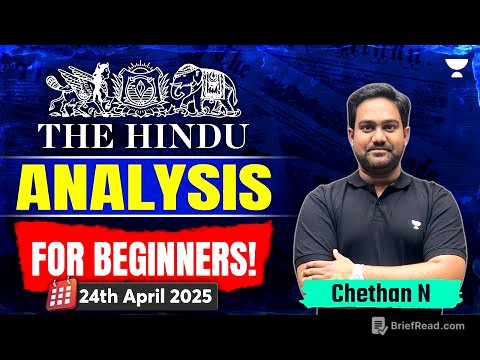TLDR;
This video presents a scalping strategy using exponential moving averages (EMAs) for trading Bank Nifty and Nifty. It emphasises the importance of identifying trending markets, selecting appropriate strike prices (ITM or ATM), and implementing strict risk management with small stop losses. The strategy aims for an 80-90% accuracy rate with a 1:2 risk-reward ratio. The video also highlights the significance of considering both Nifty and Bank Nifty charts simultaneously to improve trade accuracy and avoid false signals.
- Use of 9 and 15 period EMAs to identify trends.
- Emphasis on trading in ITM or ATM options for better delta.
- Risk management with small stop losses and 1:2 target.
- Consideration of both Nifty and Bank Nifty charts for confirmation.
Introduction to Scalping Strategy [0:00]
The video introduces a scalping strategy that Mayank Singh has been using for three years. Scalping involves staying in a trade for a short period to make quick profits. The strategy boasts an accuracy of approximately 80%, potentially reaching 90% with proper execution. A key advantage is the small stop loss, allowing for a 1:2 risk-reward ratio. The video aims to help retailers with smaller capital earn regular income through scalping, contrasting it with intraday trading, which is more suited for those with larger capital due to the risk of significant losses.
Setting Up Exponential Moving Averages (EMAs) [2:17]
To implement the strategy, two Exponential Moving Averages (EMAs) are used. These are added to the chart by searching for "Moving Average Exponential" in the indicators section and clicking it twice. The lengths of the EMAs are set to 9 and 15 periods. The 9-period EMA represents the average price over the last 9 candles, while the 15-period EMA represents the average price over the last 15 candles. Different colours are assigned to each EMA for clear distinction.
Identifying Trading Opportunities [3:08]
Trading should be avoided when the market is moving sideways or remaining flat. A trade is viable when the market is trending, with the 9-period EMA above the 15-period EMA for an upward trend, and vice versa for a downward trend. The slope of the EMAs should be at least 30 degrees from the horizontal axis to confirm a strong trend. This indicates a "Bullet Train" scenario, suggesting high momentum.
Selecting Strike Price [3:55]
When scalping, it's crucial to trade in-the-money (ITM) or at-the-money (ATM) options. ITM options are preferred for better profit potential. Out-of-the-money (OTM) options should be avoided as they are unlikely to yield profits in scalping. For example, if Bank Nifty is trading at ₹40,000, one should consider buying the ₹39,900 strike price option.
Risk Management and Capital [6:25]
The minimum capital required for this strategy is ₹25,000 to ₹30,000. Trading with less capital can spoil trading psychology and lead to premature profit booking or frequent stop-loss hits. The strategy's strength lies in its small stop loss. For instance, if a buy trade is entered, the stop loss is placed just below the entry candle's low.
Entry Criteria for Buy Trades [7:19]
Three types of candles are suitable for entering a buy trade: a P-bar candle, a bullish candle with a small wick, or a big bullish candle. The entry is made at the high of the selected candle, with the stop loss placed near the candle's low. These candles should be observed crossing above the EMAs, confirming the upward trend.
Examples of Buy Trade Entries [8:52]
For beginners, a 5-minute chart is recommended. The market should be trending with a slope of more than 30 degrees. Entry examples include a bullish candle closing above the EMAs, a pullback followed by a strong bullish candle, and a candle crossing both EMAs from below. In each case, the target is set at a 1:2 risk-reward ratio, with the stop loss placed below the entry candle's low.
Entry Criteria for Sell Trades [12:07]
For sell trades, the opposite criteria apply. The market should be in a downtrend with a slope of at least 30 degrees. A suitable entry candle is a bearish candle crossing below the EMAs. The entry is made by short selling at the low of the candle, with the stop loss placed above the candle's high. The target is set at a 1:2 risk-reward ratio.
Examples of Sell Trade Entries [12:51]
Examples of sell trade entries include a candle crossing from above with overall DR trade, a re-entry after a false bullish candle, and a strong bearish candle touching the EMA. In scalping, it's important not to wait for a single reversal candle and to re-enter if the setup remains valid.
Trading Nifty and Bank Nifty Together [15:08]
This strategy should be implemented by monitoring both Nifty and Bank Nifty charts side by side. If a sell trade is identified in Nifty, Bank Nifty should not be trading at its support level. Conversely, if a buy trade is identified in Nifty, Bank Nifty should be showing buying momentum from its support level. This cross-validation increases the probability of a successful trade.
Conclusion [18:17]
The video concludes by encouraging viewers to backtest the strategy and implement it effectively. It reiterates the importance of trading both Bank Nifty and Nifty together to avoid wrong trades. The strategy is presented as a viable option for retail traders to grow their capital through scalping. Viewers are encouraged to like the video, share it with friends, and subscribe to the channel for more informative content.









